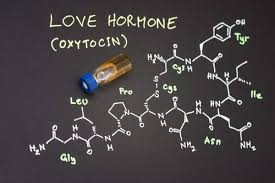Oxytocin
Many of us have heard of it as the “feel good hormone”, it’s release is triggered as a mother nurses her infant–triggering maternal-infant bonding. It’s released when we fall in love with somebody as well. For folks with diabetes insipidus–a condition unrelated to blood sugar, but found when the kidneys do not concentrate urine adequately, oxytocin can help increase the kidney concentrating power to save water.
We commonly see diabetes insipidus in complex chronic illnesses such as Chronic Inflammatory Response Syndrome (CIRS), Chronic Fatigue Syndrome, Chronic Lyme, and similar complex illnesses. When used as an intra-nasal spray, it can correct the renal deficiency allowing the kidneys to concentrate urine properly.
Oxytocin has a variety of other beneficial effects;
- Promotes emotional attachment.
- Solidifies relationships.
- Crystallizes emotional memories.
- Facilitates childbirth & breast feeeding.
- Increases sexual arousal.
- Reduces cravings for illicit drugs.
- Improves social skills.
- Triggers protective instincts.
- Induces sleep.
- Reduces stress.
Stress reduction is a big benefit of oxytocin
–especially when suffering from a complex chronic illness such as those above. A scientific article from 2003; Social Support and Oxytocin Interact to Suppress Cortisol and Subjective Responses to Psychosocial Stress explores how this happens at the biochemical level. Oxytocin directly effects the adrenal glands to accomplish this.
“Cushing’s Syndrome” occurs in complex chronic illnesses. This causes the adrenal glands to produce excessive amounts of cortisol which is normally reduced with inflammation and stress–so it’s not surprising that the inflammation & stress in a complex chronic illness would do this.
The “Cushings” cortisol response is also common in the autonomic nervous system’s sympathetic “fight or flight” state–which these diseases lock the brain into.
Unfortunately, the adrenal glands eventually “burn out” leading to low cortisol in the face of excessive demand, known as “Addison’s Disease”–a very unhealthy situation as the coping mechanisms are now lost.
It’s important to do a “manual reset” of sorts in the brain, to switch from the Sympathetic to the Parasympathetic “heal & renew” state where healing will occur.
Now that we understand the benefits of Oxytocin in reducing the need for high outputs of cortisol, there are other ways to augment this recovery from excess sympathetic stimulation:
Dynamic Neural Retraining System (DNRS)
Annie Hopper has produced a system for retraining the brain to promote healing; https://retrainingthebrain.com or (800) 947-9389 which can be purchased as a DVD set for $250. The Autonomic Nervous System consists of the Sympathetic “fight or flight” & Parasympathetic “Grow & Heal” divisions. Her Dynamic Neural Retraining System (DNRS) helps to put the brain (& thus the rest of the body) back into the correct balance for healing, accelerating recovery from CIRS, Mast Cell Activation Syndrome (MCAS), Multiple Chemical Sensitivity (MCS) & ElectroMagnetic Field Sensitivity (EMF) among other chronic complex illnesses. Her system has a proven track record. I highly recommend it to help speed (and in severe cases simply enable) recovery.
Heartmath is another solution for $150.00
There are also several articles to help boost parasympathetic activity.
So; the upshot of all of this is that switching from a sympathetic to a parasympathetic state allows for faster healing and recovery from complex chronic illnesses. There are many ways we can do this allowing for a more rapid recovery.
- COVID UPDATE: What is the truth? - 2022-11-08
- Pathologist Speaks Out About COVID Jab Effects - 2022-07-04
- A Massive Spike in Disability is Most Likely Due to a Wave of Vaccine Injuries - 2022-06-30


